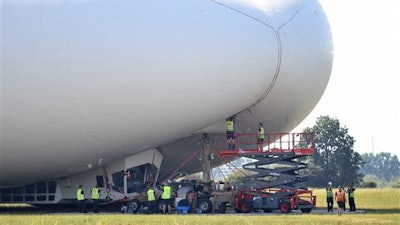
LONDON (AP) — The developer of the world's largest aircraft says the blimp-shaped airship sustained damage after it made a bumpy landing Wednesday on its second test flight in eastern England.
Hybrid Air Vehicles said it is trying to figure out what caused the rough landing of the 302-foot (92-meter) Airlander 10 during its 100 minute flight Wednesday in Bedfordshire, north of London.
"The Airlander experienced a heavy landing and the front of the flight deck has sustained some damage, which is currently being assessed," the company said. "Both pilots and the ground crew are safe and well and the aircraft is secured and stable at its normal mooring location."
A hybrid of blimp, helicopter and airplane, it can stay aloft for days at a time and has been nicknamed the "flying bum" because of its bulbous front end.
The aircraft was initially developed for the U.S. military for use in surveillance in Afghanistan.






















